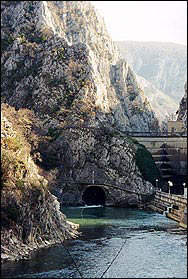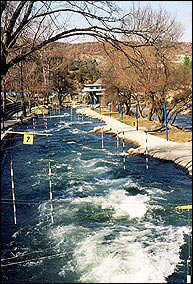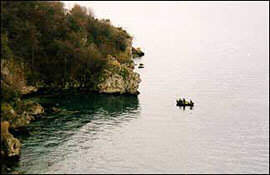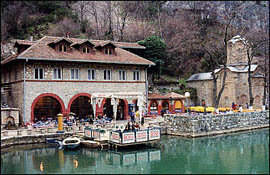 GEOGRAPHICAL DATA GEOGRAPHICAL DATA |

 Location Location |

The Republic of Macedonia is a South-European state. It is situated in the central part of the Balkan Peninsula. It borders the Federal Republic of Yugoslavia to the North, the Republic of Bulgaria to the East, the Republic of Greece to the South and the Republic of Albania to the West. Situated in this area of Europe and the Balkans, the Republic of Macedonia has a good geographical position. Such geographical features give broad opportunities for geographic connections, traffic communications and economic links. The Republic of Macedonia belongs to the group of small continental states, because it occupies an area of 25,713 square kilometers, and has population of 1,945,932 inhabitants (according to the 1994 Census).
The Republic of Macedonia is a mountainous country with many lowlands. Around 80% of the territory is mountainous and hilly, and 20% is plain terrain. The average altitude of the whole territory is 850 meters. There are 14 high mountains in Macedonia. They cover a total territory of 8,469 square kilometers or 33% of the territory of the Republic, and are spread throughout all parts of the country. The highest among them is the mountain Korab (peak Golem Korab, 2,764 m) and the lowest is Belasica (2,029 m). Other significant high mountains are: Sar Planina, Bistra, Stogovo, Jakupica, Galicica, Pelister, Nidze, Kozuv, Osogovo etc.

There are 19 lowlands in Macedonia, occupying a total area of 7,690 square kilometers or 33,8% of the state's territory.
Out of this area, 4,900 square kilometers belong the fields (valley bottoms), amounting 19,10% of the total surface of Macedonia. The fields are presented in all parts of the country. Their area is different, from 25 square kilometers - Debarsko Pole - up to Pelagonija, or Bitolsko and Prilepsko Pole - 1,373 square kilometers.
 Climate Climate |
The climate in Macedonia is diverse. In the Southern part of the country it is altered Mediterranean, in the central and Northern areas it is moderate continental, and on high mountains - mountainous. The average annual temperature is 11.5 degrees centigrade. The warmest month is July with an average air temperature of 22 degrees centigrade, while the coldest month is January, with an average temperature of -3 degrees centigrade. |
 Hydrography Hydrography |

A developed hydrographic net characterizes Macedonia. It has numerous springs, a wide river net and many natural and artificial lakes. Strong springs or wellsprings can mainly be found on limestone terrains. Such are the springs Ostrovi near the monastery "St.Naum", the spring of Vardar - Vrutok or Rasce, from which Skopje is supplied with water.
The rivers in Macedonia belong to three basins: the Aegean Basin, the Adriatic Basin and the Black Sea Basin. The Vardar is the longest and the most significant river in Macedonia. Its total length is 388 kilometers, of which 301-kilometers belong to our country. The most significant river in the Adriatic river basin is the Crn Drim with its tribute Radika, while in the area of the Black Sea Basin the srpingwell of the Binecka Morava is located.
The natural lakes in Macedonia are certainly the greatest touristic attractions of the country: "Besides the environment as our main focus, a special accent was placed onto the tourism sector. Macedonia is so rich with places where the natural beauty and the cultural inheritance are mixed together" says the Minister of Environment & Urban Planning, Mr. Marjan Dodovski.

The lakes are mainly of tectonic origin -the Ohrid Lake, the Prespa Lake and the Doiran Lake. There are also other lakes that are of glacial origin. The Ohrid Lake is located in the far South-Western part of the state, in the lowland of Ohrid. The Prespa Lake is situated in the lowland of Prespa. The border between the Republic of Macedonia, the Republic of Albania and the Republic of Greece is on the lake, and it is divided to these three states. The Doiran Lake is situated in the South-Eastern part of Macedonia. It covers an area of 43.1 square kilometers, divided between the Republic of Macedonia (27,3 square kilometers) and the Republic of Greece (15.8 square kilometers).

There are artificial lakes in almost all parts of Macedonia. The biggest among them are: Mavrovo Lake on the river Mavrovska Reka, Glabocica and the Debar Lake in the flow of the river Crn Drim, Matka on the Treska River, the Tikves Lake on the River Crna, Kalimanci on the flow of Bregalnica, Strezevo on the river Semnica, Glaznje and Lipkovo Lake on the river Lipkovska Reka, Mantovo on the river Kriva Lakavica, etc. |

